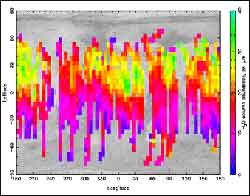Water and methane maps overlap on Mars: a new clue?

Water vapour concentration
Recent analyses of ESA’s Mars Express data reveal that concentrations of water vapour and methane in the atmosphere of Mars significantly overlap. This result, from data obtained by the Planetary Fourier Spectrometer (PFS), gives a boost to understanding of geological and atmospheric processes on Mars, and provides important new hints to evaluate the hypothesis of present life on the Red Planet.
PFS observed that, at 10-15 kilometres above the surface, water vapour is well mixed and uniform in the atmosphere. However, it found that, close to the surface, water vapour is more concentrated in three broad equatorial regions: Arabia Terra, Elysium Planum and Arcadia-Memnonia. Here, the concentration is two to three times higher than in other regions observed. These areas of water vapour concentration also correspond to the areas where NASA’s Odyssey spacecraft has observed a water ice layer a few tens of centimetres below the surface, as Dr Vittorio Formisano, PFS principal investigator, reports.
New in-depth analysis of PFS data also confirms that methane is not uniform in the atmosphere, but concentrated in some areas. The PFS team observed that the areas of highest concentration of methane overlap with the areas where water vapour and underground water ice are also concentrated. This spatial correlation between water vapour and methane seems to point to a common underground source.
Initial speculation has taken the underground ice layer into account. This could be explained by the ‘ice table’ concept, in which geothermal heat from below the surface makes water and other material move towards the surface. It would then freeze before getting there, due to the very low surface temperature (many tens of degrees Celsius below zero). Further investigations are needed to fully understand the correlation between the ice table and the presence and distribution of water vapour and methane in the atmosphere.
In other words, can the geothermal processes which ‘feed’ the ice table also bring water vapour and other gases, like methane, to the surface? Can there be liquid water below the ice table? Can forms of bacterial life exist in the water below the ice table, producing methane and other gases and releasing them to the surface and then to the atmosphere?
The PFS instrument has also detected traces of other gases in the Martian atmosphere. A report on these is currently under peer review. Further studies will address whether these gases can be linked to water and methane and help answer the unresolved questions. In-situ observations by future lander missions to Mars may provide a more exhaustive solution to the puzzle.
Media Contact
More Information:
http://www.esa.intAll latest news from the category: Earth Sciences
Earth Sciences (also referred to as Geosciences), which deals with basic issues surrounding our planet, plays a vital role in the area of energy and raw materials supply.
Earth Sciences comprises subjects such as geology, geography, geological informatics, paleontology, mineralogy, petrography, crystallography, geophysics, geodesy, glaciology, cartography, photogrammetry, meteorology and seismology, early-warning systems, earthquake research and polar research.
Newest articles

Parallel Paths: Understanding Malaria Resistance in Chimpanzees and Humans
The closest relatives of humans adapt genetically to habitats and infections Survival of the Fittest: Genetic Adaptations Uncovered in Chimpanzees Görlitz, 10.01.2025. Chimpanzees have genetic adaptations that help them survive…

You are What You Eat—Stanford Study Links Fiber to Anti-Cancer Gene Modulation
The Fiber Gap: A Growing Concern in American Diets Fiber is well known to be an important part of a healthy diet, yet less than 10% of Americans eat the minimum recommended…

Trust Your Gut—RNA-Protein Discovery for Better Immunity
HIRI researchers uncover control mechanisms of polysaccharide utilization in Bacteroides thetaiotaomicron. Researchers at the Helmholtz Institute for RNA-based Infection Research (HIRI) and the Julius-Maximilians-Universität (JMU) in Würzburg have identified a…



